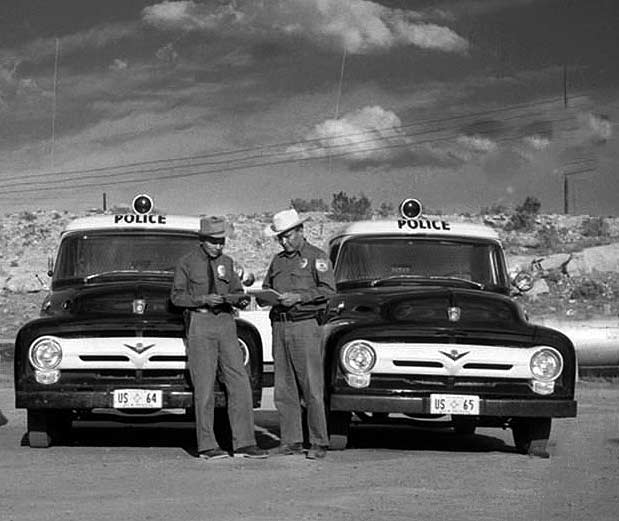
50 years ago: A new police chief brings changes in public safety

Historical photo of Navajo Nation Police.
The new police chief for the Navajo Tribe is promising to make some sweeping changes to make the department more professional and to bring it up to the 20th century.
He has also agreed, to the relief of a number of officers, to honor Navajo tradition but only to the point where it doesn’t affect the life and safety of the people the department is sworn to protect.
Allen Adams, police chief of the Glendale, Ariz. police department, signed a five-year employment contract with the Navajo Tribe on Feb. 20 to head the 180-member department. The contract calls for him to receive $15,000 a year.
The Navajo Tribal Council had approved his contract in January, primarily because he had worked for the tribal police department in 1963 and council members figured that he knew the problems the police department had.
In talking to members of the media in his first few weeks in office, Adams promised to modernize the police department, which was still facing the major problem of covering a reservation the size of West Virginia with technology that was easily in use before World War II in many areas of the country.
One of the biggest problems the department faced, he said, was the size of the area the department protected and the fact that there were many parts of the reservation where communication between the officer and his superiors were impossible.
Because of the low number of officers, police often had to go alone to handle calls and Adams said this put his officers in danger because if the officer was in a “dead zone,” it could be hours before backup could arrive.
There were solutions to this, he said, but it was going to cost money and he was planning to seek funding from the Bureau of Indian Affairs to eliminate as many of these dead spots as possible.
Another area Adams said he planned to address was to set up guidelines for officers who were worried about their job interfering with their culture.
In the early years of the tribal police department, Adams learned that officers often had to ignore their traditional teachings if they wanted to be effective police officers.
One of the worst situations dealt wit death and the fact that police officers often came into close contact with a person who had recently died, either from natural causes (for instance, exposure) to unnatural causes (homicide victims or death caused by accident).
To handle the backlash, from a cultural standpoint, the department urged officers who had problems from a traditional standpoint, to have the necessary ceremonies done by medicine men.
The practice was not only to benefit the officers but members of the officer’s family – parents and grandparents – who worried about the officer’s well being if he (and it was “he” because there were very few female officers in those days) came into contact with death so much.
By the 1960s, the problem was diminishing as the department began hiring officers who weren’t from a traditional background or who were wiling to deal with the problem much like Navajo nurses and caregivers did when they came upon death.
But there was one area that Adams agreed to make an exception. That dealt with officers whose wives were pregnant.
Officers who worked for the department in the 1960s and 1970s would mention this during interviews with the Times, saying police supervisors had a solution to deal with this kind of situation.
What they would do is allow officers with pregnant wives to sit out those kinds of calls that could potentially have them come in contact with people who were dying or who were already dead.
While this would create some problems with staffing, police chiefs like Adams, Roland Dart and Phillip Meek in the future said they would work with officers to make sure that these kinds of situations were handled in the best way possible to accommodate traditional beliefs as well as improve morale.
In other news this week, it appears that Annie Wauneka has decided to lead another crusade.
Back in the 1950s, as Navajos were dying of tuberculosis by the hundreds, Wauneka had almost single-handedly led a crusade to convince Navajos to go to government hospitals for treatments, overcoming traditional beliefs to stay away from hospitals and clinics because that is where people died.
Her latest crusade was against a proposal by the Bureau of Indian Affairs to spend $11 million to build an Indian high school in Albuquerque that would admit Native students from all over the Southwest.
Wauneka and others in the tribe were pushing the BIA to use the $11 million to build dormitories in or near border communities such as Gallup, Farmington and Winslow so that Navajo students could attend public schools in those towns.
Not only would this be more cost effective, said Wauenka, but studies had shown that Navajo children have been educated more effectively in schools near the reservation “where children may be closer to their homes and parents.”
Because of her efforts, the Navajo Tribal Council would pass a resolution in early March supporting this position and within a couple of years, funds would be supplied by the BIA education budget to start building border town dorms.
To read the full article, pick up your copy of the Navajo Times at your nearest newsstand Thursday mornings!
Are you a digital subscriber? Read the most recent three weeks of stories by logging in to your online account.








 Highway 264,
Highway 264, I-40, WB @ Winslow
I-40, WB @ Winslow